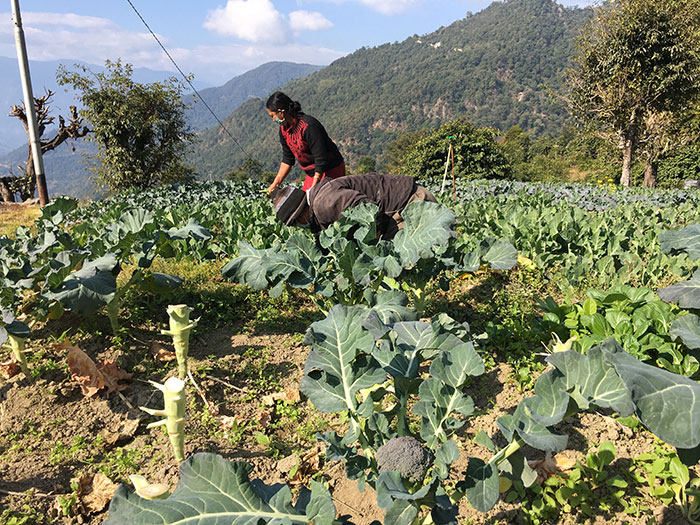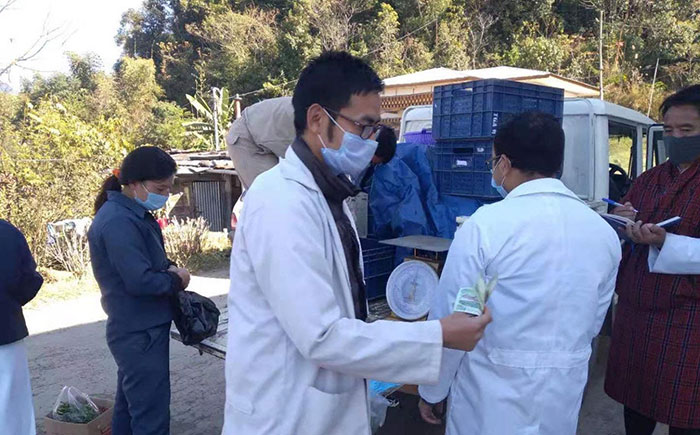Chimi Dema | Tsirang
A kilogram (kg) of small green chilli is sold at Nu 250 at the farm in Dagana which is Nu 50 less than the farmgate price fixed by the agriculture ministry.
In Tsirang, most farmers sell at Nu 300 for a kg.
Of late, many on social media blamed farmers and vendors for taking advantage of the pandemic and hiking vegetable prices.
A kg of green chilli, for example, in most places costs not less than Nu 500 in Thimphu.
While the farmgate prices are reasonable, officials in Dagana said that the marginal cost added by a series of vendors between producers and consumers make it expensive for consumers.
“When vendors make the same amount of profit overnight, which our farmers take more than a year, the vegetables would become expensive,” an official said.
“For instance, farmers sell cauliflower at Nu 80 a kilogram here but it becomes at least Nu 160 once it reaches to consumers in Thimphu.”
The price of local vegetables and fruits, according to officials, was fixed by the agriculture ministry to ensure that sixty percent of the price is paid to farmers and remaining forty percent to wholesalers and retailers.

Farmer Phurba Moktan and his wife harvest vegetables in Mendrelgang
In Sergithang gewog under Tsirang, although farmers were asked to follow the fixed price, agriculture officials said that prices differ from vendor to vendor.
“For a kg of green chilli, some vendors pay even Nu 350 given the limited supply,” the official said.
Cabbages at the most cost only Nu 40 a kg, whereas the farmgate price is fixed at Nu 70.
Many in the dzongkhag raised the need for sustainable market linkage between consumers and producers.
The officials suggested that deploying youths on a payment system or public vehicles to transport vegetables could help keep prices lower.
A farmer in Sergithang, Sanman Subba said that establishing a sustainable market linkage could prevent unnecessary blame on farmers.
“The prices so far has been reasonable considering the cost of production,” he said.
Meanwhile, as a token of gratitude, Tsendagang gewog officials collected 125kg of small green chillies from Samerchu chiwog and sold at Nu 250 a kg to frontliners in Dagapela, yesterday.
In Tsirang, with two commercial aggregators from each gewog linking farmers to markets, villagers could sell as much as they produced despite the nationwide lockdown.
A farmer in Mendrelgang, Tsirang, Phurba Moktan sold about 270kgs of vegetables from his farm since lockdown began on December 23. He earned Nu 18,000 in less than a week.
Phurba Moktan said that the situation this time is better compared to the first nationwide lockdown in August. “There was no problem with marketing our farm produces so far. This encourages us to focus more on vegetable production.”
It has been three years since he ventured into commercial vegetable cultivation. He has grown cauliflower, cabbage, broccoli, chillies and other vegetables on a three-acre field.
Another farmer in the gewog, Dawa Dorji Tamang who grew vegetables on a six-acre land has sold 500kgs so far this season. “Business has been good so far.”
However, given the huge potential for vegetable production in his farm in the following weeks, he said he is worried if he would be able to sell them.
“It would be helpful if major producers are allowed to supply on their own instead of routing through aggregators,” Dawa Dorji Tamang said.
The dzongkhag agriculture officials, however, said that only two aggregators were identified to abide by the movement restriction and other health protocols during the nationwide lockdown.
“If the need arises, we will facilitate the movement and ensure that all vegetables are sold,” the official said.
Meanwhile, Tsirang so far sourced more than 12 metric tonnes of vegetables and over 6,000 bundles of leafy vegetables to Thimphu, Paro and Wangdue.


